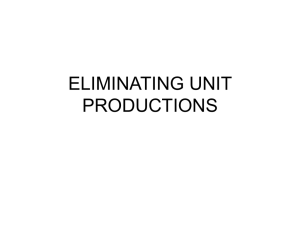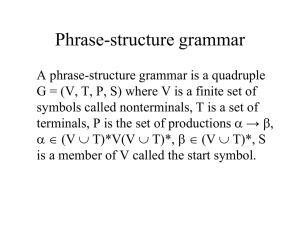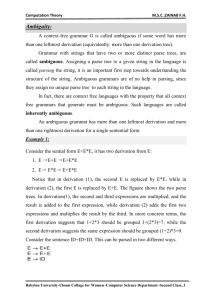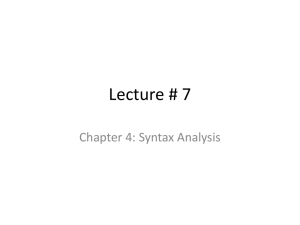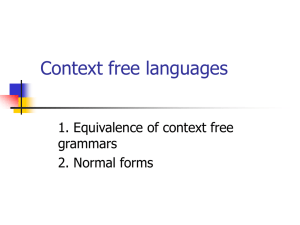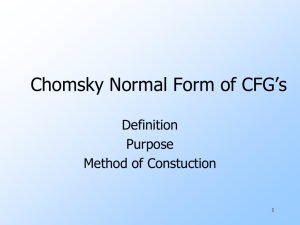Normal Forms
advertisement
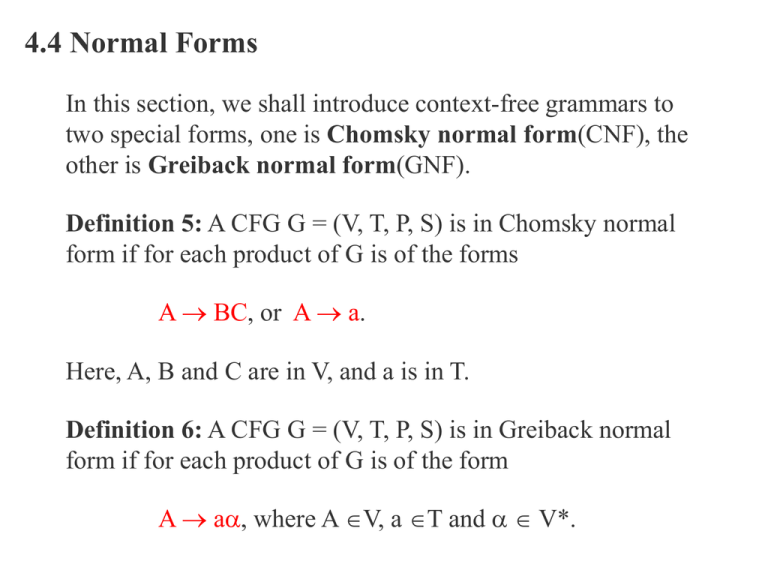
4.4 Normal Forms
In this section, we shall introduce context-free grammars to
two special forms, one is Chomsky normal form(CNF), the
other is Greiback normal form(GNF).
Definition 5: A CFG G = (V, T, P, S) is in Chomsky normal
form if for each product of G is of the forms
A BC, or A a.
Here, A, B and C are in V, and a is in T.
Definition 6: A CFG G = (V, T, P, S) is in Greiback normal
form if for each product of G is of the form
A a, where A V, a T and V*.
-productions
An -production is of the form A .
But, if the language L generated by a grammar G does not include
, we can modify the grammar G to an equivalent grammar G’ so
that there are no -productions in G’.
The algorithm to modify a grammar G to G’ is as follows.
while ( there is a an -production A in G ) do
remove the -production A from G
If there is a production B xAy from G,
then add a production B xy to G
Example 20: Consider the grammar G
S 0T0 | 1T1
T 0T0 | 1T1 |
Then L(G) = L = { x x R | x T*, and x }.
We can modify the above grammar to a grammar without productions as the following and generating the same language L.
S 0T0 | 1T1 | 00 | 11
T 0T0 | 1T1 | 00 | 11
The above grammar is equivalent to the following grammar.
S 0S0 | 1S1 | 00 | 11
Useless variables
A is a useful variable if A * w for some w T*.
For a CFG G, we can modify the grammar G to an equivalent
grammar G’ so that there are no useless variables in G’.
The algorithm to modify a grammar G to G’ is as follows.
First, let the set S , flag TRUE
while ( flag ) do // get useful variables
flag FALSE
If B T* in G, or B x 1A 1x 2A 2… x k A ky in G,
where y, x i T* and A i S, i = 1,2, …, k,
then S S {B}, flag TRUE
The set V \ S is a set of useless variables.
Next, if there is a useless production
B x 1A 1x 2A 2… x k A ky in G, where y, x i T* and one of
B and A i, i = 1,2, …, k, is in V \ S,
then remove the production B x 1A 1x 2A 2… x k A ky from
G.
The algorithm to remove useless variables and useless productions
from the grammar G to get an equivalent grammar G’ without
useless variables and useless productions.
Unit productions
A unit production is of the form AB, where A and B are variables.
A unit production basically is a redundant production. Therefore,
we can eliminate the unit productions by the following method:
For each unit production AB, remove the production from
the grammar, and add the following productions:
For each non-unit production Bw in G, add the
production A w to G.
By the above algorithms, we are able to obtain the following
theorem.
Theorem 5 : For each CFL L without , there is a CFG G with
no useless variables, -productions or unit productions such that
L(G) = L.
Theorem 6 : For each CFL L without , there is a CFG G in
Chomsky normal form such that L(G) = L, i.e., each production in
G is of the form A BC, or A a ,where A, B and C are in V,
and a is in T.
Proof :
For each CFL L without , there is a CFG G with no useless
variables, -productions or unit productions such that L(G) = L.
First step, for each production A in G, if || = 1, then T.
Otherwise, || > 1, say = X 1X 2…X k, k>1.
If X i , say i =1and X1= a, is a terminal and there is a production
B a, then replace X 1 by B to get a new production A BX 2…X
k , and remove the production A .
If X i , say i =1and X 1 = a, is a terminal and there is no production
Ba, then add a new variable C, and replace X 1 by C to get a new
production A CX 2…X k , remove the production A and add
a new production C a.
After the first step, all productions are of the form either
A a, or
A , where || >1 and V+
Second step, for each production of the form A , where || >1,
we know that V+. If || = 2, then we do not need to modify the
production.
If || > 2, say = X 1X 2…X k, k>2, then we need to introduce new
variables Y 1 , Y 2 , … , Y k-2, and add the new productions as follows.
A X 1Y 1
Y 1 X 2Y 2
Y i X i+1Y i+1, i = 1, 2, …, k3,
Y k-3 X k-2Y k-2
Y k-2 X k-1X k
Therefore, we can modify the grammar to a new equivalent
grammar in Chomsky normal form.
Theorem 7 : For each CFL L without , there is a CFG G in
Greiback normal form such that L(G) = L.
Proof :
For each CFL L without , there is a CFG G’’ with no useless
variables, -productions or unit productions such that L(G’’) = L.
By theorem 6, there is a CFG G’=(V’, T, P’, S’) in Chomsky
normal form such that L(G’) = L(G’’) = L.
Rewrite the k variables in V’ with indices 1, 2, …, k. Let it be V =
{A 1, A 2, …, A k} and the start variable is A 1.
First step, modify the productions into the forms
A i a, where a T and V*, or
A i A j , where j >i
To achieve the result, we start from A 1.
If there is a production A 1 a, where a T and V*, then
we keep the production.
If there is a production A 1 A 1, then apply theorem 4 in
section 4.2 to revise the left recursive production to a right
recursive production until there is no A 1 recursive production.
Next we revise the A 2 productions until A k.
A possible algorithm for this step is as follows.
for i=1 to k do
for j=1 to i 1 do
for each production A i A j do
for each production A j do
add production A i
remove production A i A j
for each production A i A i do
add productions B i and B i B i
remove productions A i A i
for each production A i , where does not
begin with A i do
add production A i B i
After the first step, the productions are of the forms:
A i a, where a T and V*,
A i A j , where k j > i, or
B i , where ( V{B 1 , B 2 ,…, B i1} )*.
The A k production must be of the form A k a, where a T and
V*,
The B i production must be of the form
B i A j , where (V {B 1 , B 2 ,…, B i1}) *, or
B i a, where a T and (V {B 1 , B 2 ,…, B i1}) *,
Second step, modify each A i production into the forms
A i a, where a T and V*.
To achieve the result, we start from A k1 to modify the A k1
productions so that the right side of the production starting with
a terminal. Then proceed the same process until A 1.
A possible algorithm for this step is as follows.
for i=k 1 to 1 do
for j=k to i +1 do
for each production A i A j do
for each production A j do
add production A i
remove production A i A j
Third step, modify each B i production into the forms
B i a, where a T and V*.
A possible algorithm for this step is as follows.
for i=1 to k do
for each production B i A j do
for each production A j do
add production A j
remove production B i A j
Example 21: Consider the grammar G
S 0S0 | 1S1 | 00 | 11
An equivalent CFG in GNF is
S 0SZ | 1SY | 0Z | 1Y
Y1
Z0
An equivalent CFG in CNF is
S ZX | YW | ZZ | YY
X SZ
W SY
Y1
Z0
Example 22: Convert the grammar G in CNF to a grammar in GNF :
A 1 A 1 A 2| A 3 A 1
A 2 A 1 A 3| 0
A3 A1A2 | 1
Solution:
First stage:
Step 1: Introduce variable B 1 to modify the productions
A 1 A 1 A 2| A 3 A 1 to the following productions:
A1 A3A1 | A3A1 B 1
B 1 A2 | A2 B 1
Step 2: Modify the productions A 2 A 1 A 3 | 0 to the
following productions:
A2 A3A1A3 | A3A1 B 1A3 | 0
Step 3: Modify the productions A 3 A 1 A 2 | 1 to the
following productions:
A3 A3A1A2 | A3A1 B 1A2 | 1
Step 4: Introduce variable B 3 to modify the productions A 3
A 3 A 1 A 2 | A 3 A 1 B 1 A 2 | 1 to the following production:
A3 1 | 1 B 3
B 3 A1A2 B 3 | A1 B 1A2 B 3 | A1A2 | A1 B 1A2
After the first stage we have the following productions:
A1 A3A1 | A3A1 B 1
B 1 A2 | A2 B 1
A2 A3A1A3 | A3A1 B 1A3 | 0
A3 1 | 1 B 3
B 3 A1A2 B 3 | A1 B 1A2 B 3 | A1A2 | A1 B 1A2
Second stage:
Step 5: By A 3 productions A 3 1 | 1 B 3 , modify the A 2
productions to the following productions:
A2 1A1A3 | 1 B 3A1A3 | 1A1 B 1A3 | 1 B 3A1 B 1A3 | 0
Step 6: Modify the A 1 productions to the following productions:
A1 1A1 | 1 B 3A1 | 1A1 B 1 | 1 B 3A1 B 1
After the second stage, we have the following productions:
A1 1A1 | 1 B 3A1 | 1A1 B 1 | 1 B 3A1 B 1
A2 1A1A3 | 1 B 3A1A3 | 1A1 B 1A3 | 1 B 3A1 B 1A3 | 0
A3 1 | 1 B 3
B 1 A2 | A2 B 1
B 3 A1A2 B 3 | A1 B 1A2 B 3 | A1A2 | A1 B 1A2
Third stage:
Step 7: Modify the B productions to the following productions:
A1 1A1 | 1 B 3A1 | 1A1 B 1 | 1 B 3A1 B 1
A2 1A1A3 | 1 B 3A1A3 | 1A1 B 1A3 | 1 B 3A1 B 1A3 | 0
A3 1 | 1 B 3
B 1 1A1A3 | 1 B 3A1A3 | 1A1 B 1A3 | 1 B 3A1 B 1A3 | 0
B 1 1A1A3B1 | 1B3A1A3B1 | 1A1B1A3B1 | 1B 3A1B1A3B1 | 0B1
B 3 1 A 1A 2B 3 | 1B 3A 1A 2B 3 | 1A 1B 1A 2B 3 | 1B 3A 1B 1A 2B 3
B3 1A1B1A2B3 |1B3A1B1A2B3 |1A1B1B1A2B3 |1B3A1B1B1A2B3
B 3 1A1A2 | 1 B 3A1A2 | 1A1 B 1A2 | 1 B 3A1 B 1A2
B 3 1A1B1A2 | 1B3A1B1A2 | 1A1B1B1A2 | 1B3A1B1B1A 2
